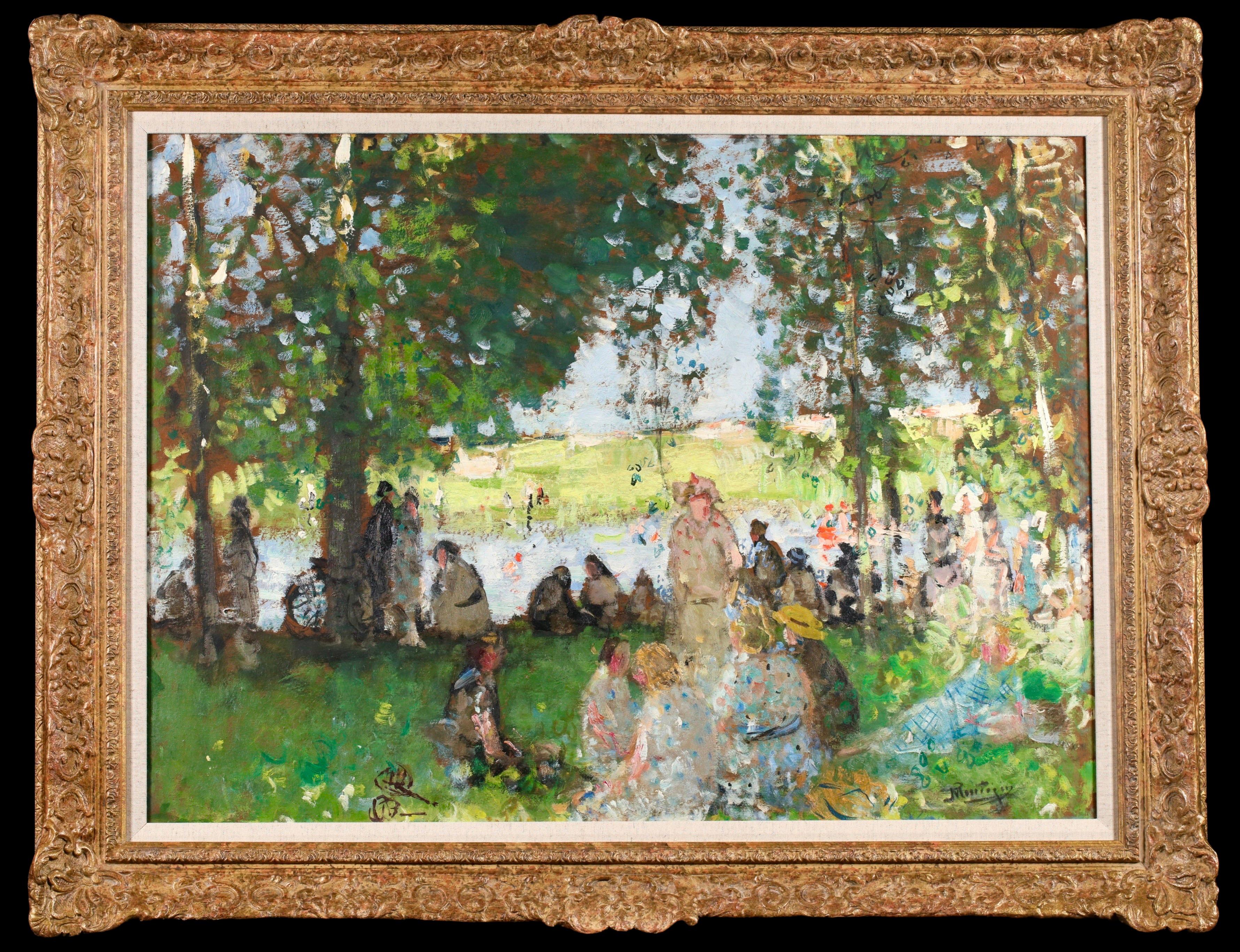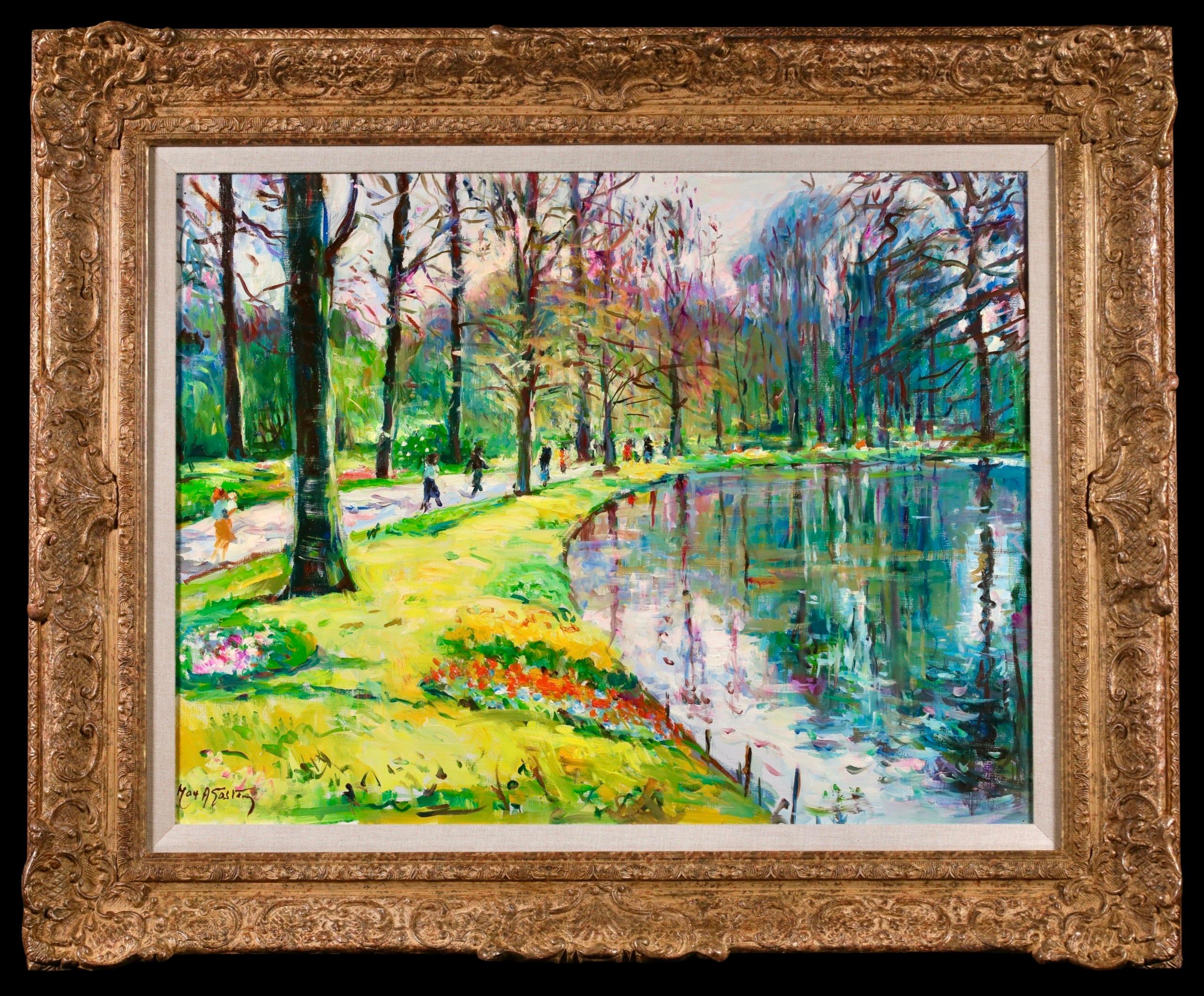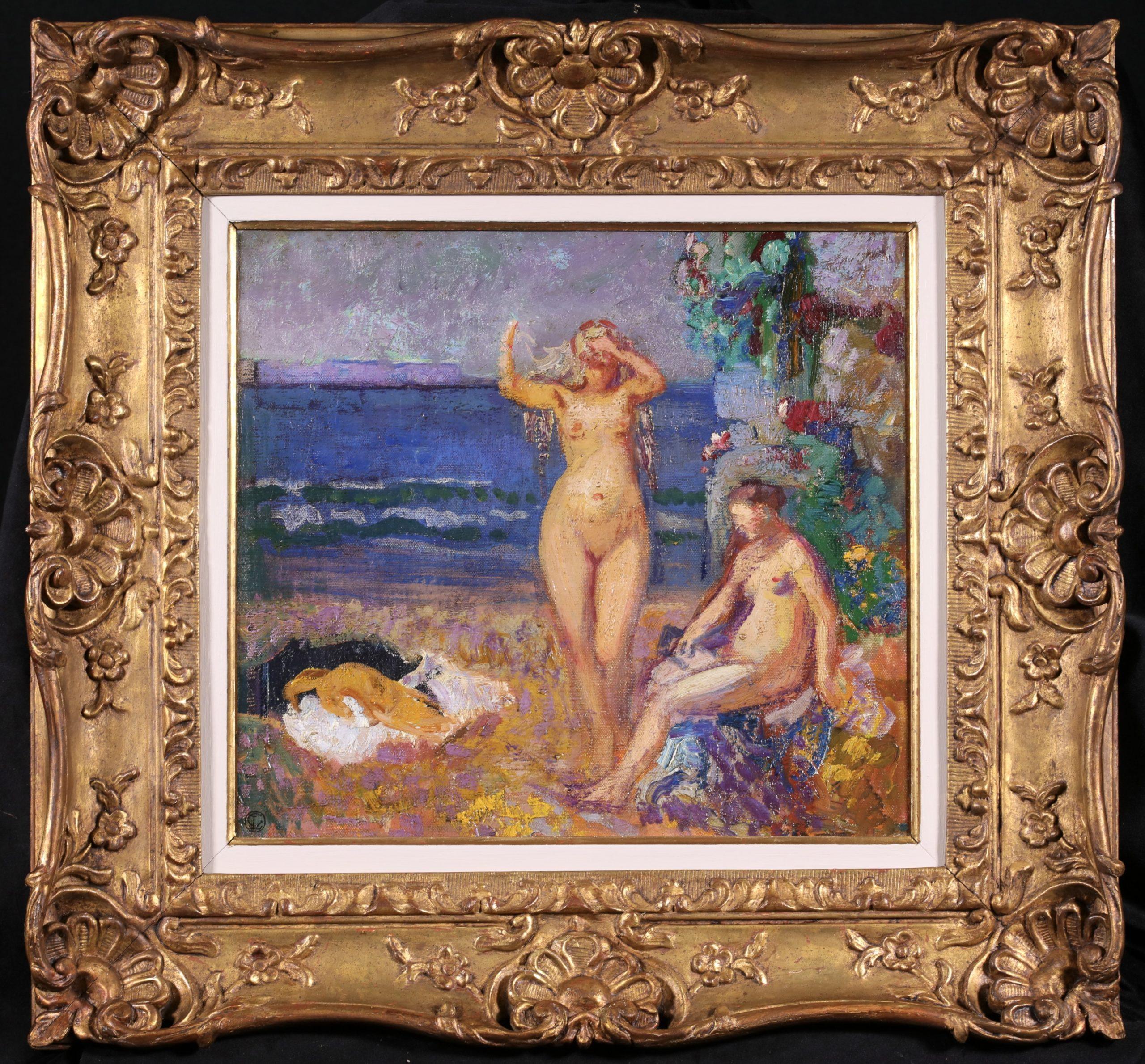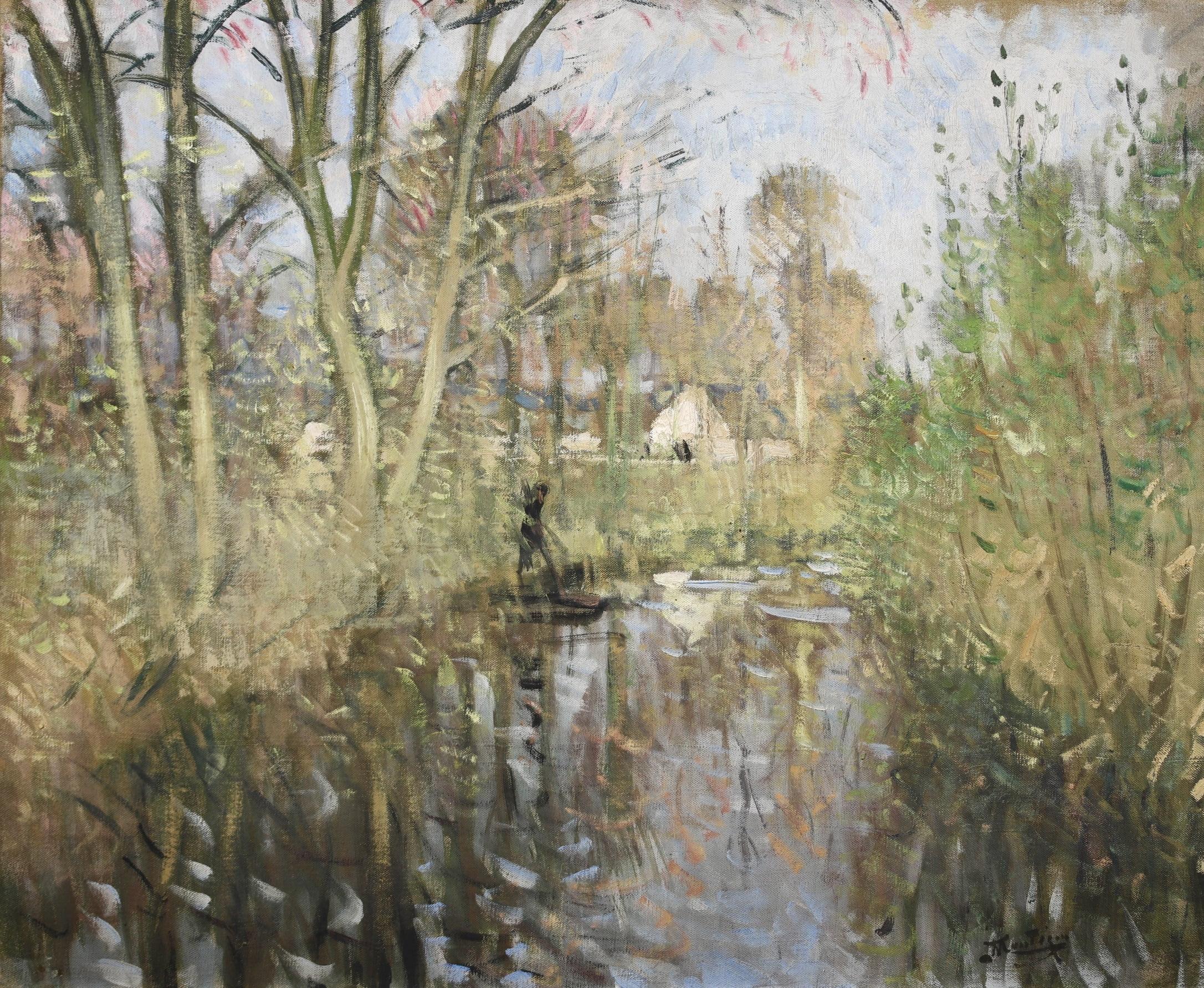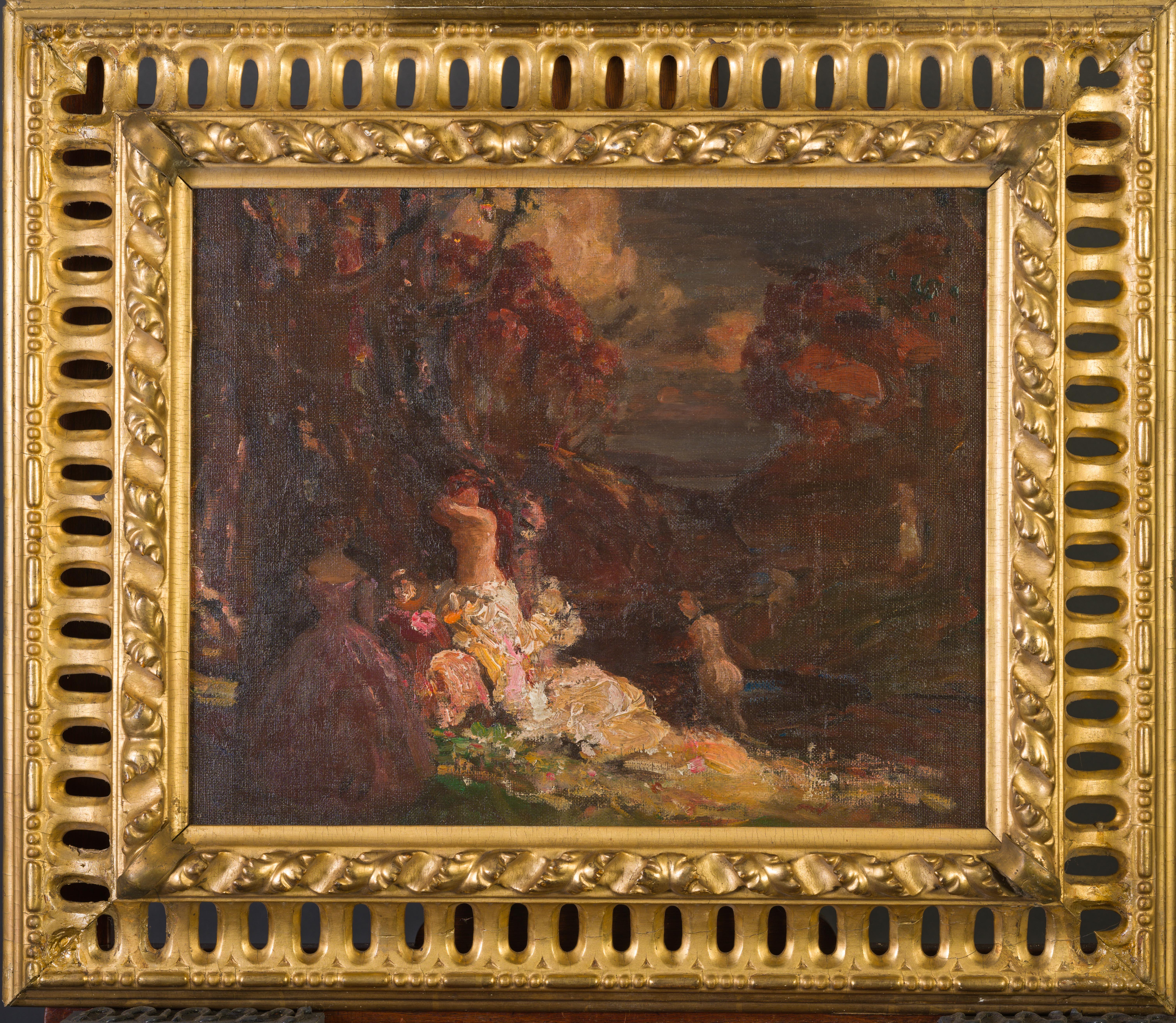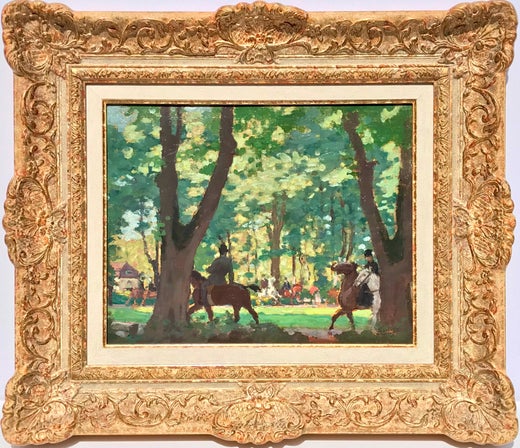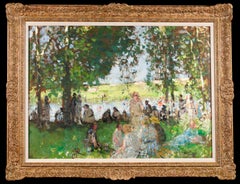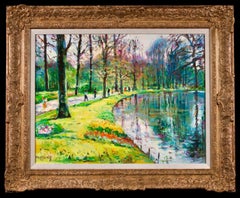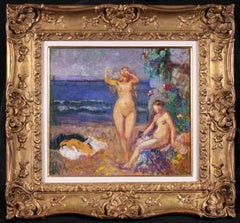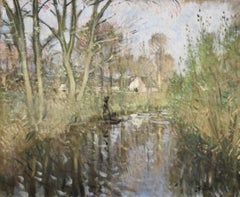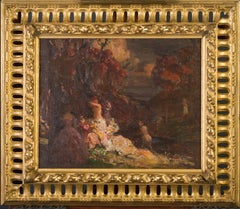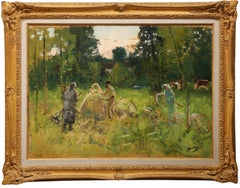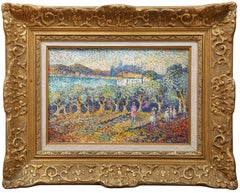Items Similar to Les Baigneuses - Post Impressionist Figures in Landscape Oil by Pierre Montezin
Want more images or videos?
Request additional images or videos from the seller
1 of 18
Pierre Eugène MontezinLes Baigneuses - Post Impressionist Figures in Landscape Oil by Pierre Montezinc.1910
c.1910
$24,338.58
£17,725
€20,744.79
CA$33,576.77
A$36,910.11
CHF 19,398.26
MX$448,223.20
NOK 241,988.44
SEK 229,267.03
DKK 154,823.64
About the Item
Signed oil on canvas figures in riverscape circa 1910 by sought after French impressionist painter Pierre Eugene Montezin. The work depicts bathers in a river on a sunny summer's day, with onlookers leaning against the railings of the bridge.
Signature:
Signed lower right
Dimensions:
Framed: 25.5"x24"
Unframed: 18.5"x17"
Provenance:
Private French collection
This work is included in the archives of Cyril Klein-Montezin
Pierre Montézin's father, a lace designer, found him a job with a design company, where he soon devoted himself to murals. Strongly influenced by the theories of Impressionism, he later embarked on a career as an artist in his own right. In about 1903 he came into contact with Quost who made him work on his drawing and gave him a taste for painting. He enlisted in 1914 for the duration of the war, and took up painting again on his return. He lived in Dreux and Moret for a year, and spent his holidays there from then on. Montézin was made a Chevalier of the Légion d'Honneur in 1923 and in 1940 was elected a member of the Académie des Beaux-Arts, taking the place left vacant by Edouard Vuillard's death.
Montézin submitted a work to the Salon des Artistes Français for the first time in 1893, but it was rejected, as were all his subsequent attempts for ten years. It was not until 1903 that he was accepted, winning a third-class medal in 1907 and a second-class medal in 1910. He also exhibited at the Salon des Artistes Français after World War I and was awarded the Rosa Bonheur prize in 1920. He was made a member of the society and honoured as hors concours, as well as being made a member of the committee and of the jury of the Salon des Artistes Français after having received their medal of honour.
Montézin's painting was well-received, his technique - a distant descendant of Impressionism - captivating many by its virtuosity.
Museum and Gallery Holdings:
Mannheim (Städtische Kunsthalle): Flowers
Paris (MAMVP): Making Hay in Normandy (1940)
Paris (Mus. du Petit Palais): Poplar Trees
- Creator:Pierre Eugène Montezin (1874-1946, French)
- Creation Year:c.1910
- Dimensions:Height: 25.5 in (64.77 cm)Width: 24 in (60.96 cm)
- Medium:
- Movement & Style:
- Period:
- Condition:Very good original condition.
- Gallery Location:Marlow, GB
- Reference Number:Seller: LFA02331stDibs: LU415315105352
Pierre Eugène Montezin
French artist Pierre Eugene Montézin, originally trained in decorative arts and mural painting under his father’s guidance. From the age of 18 he worked in a decorative atelier, painting floral panels and ornamental motifs. His exposure to the Impressionist movement inspired a pivot towards plein-air landscape paintings, setting him on the path to becoming a true Impressionist. Montézin passionately pursued Salon recognition for a decade; in 1903, he finally debuted at the Salon des Artistes Français after repeated rejections. Under the mentorship of Ernest Quost, he honed his drawing and painting technique, embracing a painterly style marked by spontaneous strokes and radiant light. Montézin enlisted during WWI and received the Médaille Militair for his service, spending significant time after the war in Dreuz and Moret-sur-Loing, painting landscapes in the tradition of Alfred Sisley with the influence of Claude Monet remaining present. Montézin remained a steadfast Impressionist, resisting contemporary movements like Cubism or Surrealism, and stayed devoted to natural, atmospheric subjects seen through ‘the heart’ as he reportedly told critic Louis Vauxcelles. He suddenly died in 1946 whilst painting Britany. Montézin’s work embodies a lifetime of devotion to light, landscape, and the authentic roots of Impressionism.
About the Seller
5.0
Gold Seller
Premium sellers maintaining a 4.3+ rating and 24-hour response times
Established in 2001
1stDibs seller since 2016
709 sales on 1stDibs
Typical response time: <1 hour
- ShippingRetrieving quote...Shipping from: Marlow, United Kingdom
- Return Policy
Authenticity Guarantee
In the unlikely event there’s an issue with an item’s authenticity, contact us within 1 year for a full refund. DetailsMoney-Back Guarantee
If your item is not as described, is damaged in transit, or does not arrive, contact us within 7 days for a full refund. Details24-Hour Cancellation
You have a 24-hour grace period in which to reconsider your purchase, with no questions asked.Vetted Professional Sellers
Our world-class sellers must adhere to strict standards for service and quality, maintaining the integrity of our listings.Price-Match Guarantee
If you find that a seller listed the same item for a lower price elsewhere, we’ll match it.Trusted Global Delivery
Our best-in-class carrier network provides specialized shipping options worldwide, including custom delivery.More From This Seller
View AllLes Vacances - Post Impressionist Figures in Landscape Oil by Pierre Montezin
By Pierre Eugène Montezin
Located in Marlow, Buckinghamshire
Signed oil on canvas figures in riverscape circa 1910 by sought after French impressionist painter Pierre Eugene Montezin. The work depicts women dressed in summer dresses and sunhat...
Category
1910s Impressionist Figurative Paintings
Materials
Canvas, Oil
L'Etang - Post Impressionist Figures in Landscape Oil by Max Agostini
By Max Michel Agostini
Located in Marlow, Buckinghamshire
Signed post impressionist figures in landscape oil circa 1980 by French painter Max Michel Agostini. The work depicts park-goers on a path beside a lake on a sunny spring day. There ...
Category
1980s Post-Impressionist Landscape Paintings
Materials
Canvas, Oil
Les Baigneuses - Neo-Impressionist Nudes in Landscape Oil by Georges Lemmen
By Georges Lemmen
Located in Marlow, Buckinghamshire
Signed oil on canvas nudes in landscape circa 1910 by Belgian neo-impressionist painter Georges Lemmen. The work depicts nude bathers on a sunny beach beside the sea.
Signature:
Signed lower left with the cachet of painter
Dimensions:
Framed: 23.5"x24.5"
Unframed: 14.5"x15.5"
Provenance:
Olivier Bertrand (expert on the painter) has confirmed the authenticity of this work
Georges Lemmen was the son of an architect and studied under Amédée Bourson at the academy in St Joost-ten-Node. He was invited in 1889 to join the Group of Twenty ( Cercle des XX) which had been launched in 1884 by Oscar Maus and had in the interim emerged as an influential force in Belgian artistic circles, not least by bringing to public and critical attention the work of such artists as Georges Seurat and Paul Signac. The Cercle des XX would be reborn in 1894 as La Libre Esthétique.
In the early days of the Cercle des XX, Lemmen espoused a pointilliste technique. His earlier painting was clearly influenced by the Neo-Impressionists; over time, however, his style became more subtle and nuanced - recalling, perhaps, that of his compatriot Van Rysselberghe, another Cercle des XX member. With the group's rebirth as the Libre Esthétique, Lemmen's work became more intimiste in character, most notably in his portraits, nudes and still-lifes, where the influence of Bonnard and Vuillard is unmistakable, as is that of Renoir, particularly after Lemmen's travels in the Midi in 1911. From this point onwards, he would go on to make a major contribution to the renewal of the graphic and decorative arts in terms of his input to the new 'free' aesthetic and to Art Nouveau. Although his draughtsmanship retained its essential purity and elegance of line, his painting became more fleshy, imprecise and sensual, his compositions governed less by technical considerations than by the urgent need to express his emotions.
Between 1889 and 1893, Lemmen exhibited at the Salon des Indépendants in Paris, aligning himself with the Neo-Impressionists. In 1893, Henry van de Velde invited him to participate in the Pour l'Art association that had been created in Antwerp. He travelled to the south of France in 1911. By this juncture, he had already exhibited solo on two occasions (in 1906 and 1908) at the Galerie Druet in Paris. A further solo exhibition in 1913, his first in Brussels, cemented Lemmen's reputation.
Museum and Gallery Holdings:
Bremen (Kunsthalle): Standing Nude Combing her Hair
Brussels (Mus. royaux des Beaux-Arts de Belgique): Children's Room (watercolour); Reading; Couture; Young Girl by the Sea...
Category
1910s Impressionist Nude Paintings
Materials
Oil, Canvas
La Chalandiere a Briere - Impressionist River Landscape Oil by Pierre Montezin
By Pierre Eugène Montezin
Located in Marlow, Buckinghamshire
Signed and titled oil on canvas riverscape by sought after French impressionist painter Pierre Eugene Montezin. The work depicts a view of a river in autumn. The trees that line the ...
Category
1910s Impressionist Figurative Paintings
Materials
Canvas, Oil
Baigneuses - Post Impressionist Nudes in Landscape Oil by Georges Pissarro
By Georges Henri Manzana Pissarro
Located in Marlow, Buckinghamshire
Signed and dated oil on board nudes in landscape by French post-impressionist painter Georges Manzana Pissarro. The work depicts nude bathers at a lake, sunbathing and paddling in th...
Category
1930s Post-Impressionist Nude Paintings
Materials
Oil, Board
Promenade Estivale - Post Impressionist Landscape Oil by Victor Charreton
By Victor Charreton
Located in Marlow, Buckinghamshire
Signed figure in landscape oil on board circa 1910 by French Post-Impressionist painter Victor Charreton. The piece depicts a lone figure taking a walk beside a stream in a wooded ar...
Category
1910s Post-Impressionist Landscape Paintings
Materials
Oil, Board
You May Also Like
Landscape with Figures
By Frans de Geetere
Located in San Francisco, CA
This artwork titled Landscape with Figures" c.1950, is a watercolor by noted Belgian artist Frans De Geetere, 1895-1968. It is signed at the lower right corner by the artist. The art...
Category
Mid-20th Century Impressionist Figurative Drawings and Watercolors
Materials
Watercolor
The Bathers ( Les Bagneuses )
By Adolphe Monticelli
Located in Douglas, Isle of Man
Adolphe Joseph Thomas Monticelli 1824-1886, was a French painter and influencer of Vincent van Gogh. Monticelli was well known to Theo and Vincent Van Gogh, Theo acted as agent for ...
Category
Late 19th Century Landscape Paintings
Materials
Canvas, Oil, Panel
Les Foins, Impressionist Oil on Canvas Painting by Pierre Eugène Montézin
By Pierre Eugène Montezin
Located in Long Island City, NY
Pierre Montezin, French (1874 - 1946) - Les Foins, Year: 1938, Medium: Oil on Canvas, signed lower right, Size: 23.75 x 31.75 in. (60.33 x 80.65 cm), Frame Size: 31.25 x 39.5 inc...
Category
1930s Impressionist Nude Paintings
Materials
Oil
Women in Meadow, Impressionist Oil Painting on canvas by Lucien Neuquelman
By Lucien Neuquelman
Located in Long Island City, NY
Lucien Neuquelman, French (1909 - 1988) - Women in Meadow, Year: circa 1938, Medium: Oil on canvas, signed lower right, Size: 9.5 x 13.75 in. (24.13 x 34.93 cm), Frame Size: 16.5...
Category
1930s Impressionist Landscape Paintings
Materials
Oil
"Park Scene" Parisian Impressionistic Oil Painting of Figures by the Riverside
By Francesco Tammaro
Located in New York, NY
Francesco Tammaro was born in Naples in 1939 where he attended the Instituto D'Arte di Napoli, one of the most reputed Fine Art schools in Italy. Shortly after graduation he traveled...
Category
Mid-20th Century Impressionist Landscape Paintings
Materials
Oil, Wood Panel
Bathers, Oil on Canvas, 1914
By Roger Grillon
Located in Saint Amans des cots, FR
Oil on canvas by Roger GRILLON (1881-1938), France, 1914. "Bathers". With frame: 114x94 cm - 44.9x37 inches ; without frame: 92x73cm - 36.2x28.75 inches. 30F format. Signed lower lef...
Category
1910s Impressionist Figurative Paintings
Materials
Canvas, Oil
